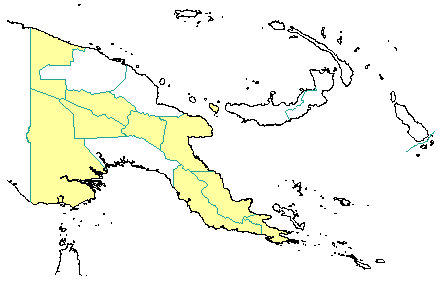
in PNGplants database
PNGTreesKey – Papuacedrus papuana (F.Muell.) Li var. papuana |
Barry Conn (NSW) & Kipiro Damas (LAE).
Guide to trees of Papua New Guinea
Copyright held by the authors, National Herbarium of New South Wales, and Papua New Guinea National Herbarium
Journal of the Arnold Arboretum Vol. 34: 25 (1953) Fig. 33.
Other Literature: P. van Royen, Alpine Flora of New Guinea 1-6 (1979)
Family: Cupressaceae
Conifer
Timber Group: Softwood Tradename: Papuacedrus
Field Characters: Emergent tree, Large canopy tree (up to 35 m high), or Small sub-canopy tree; Bole cylindrical (up to 100 cm diam.); straight (mostly bole 10-20 m long); buttresses buttresses absent (sometimes slightly fluted); spines spines absent; aerial roots aerial roots absent; stilt roots stilt roots absent; Bark grey or brown to black, rough, fissured to peeling; Subrhytidome (under-bark) dark brown; more than 25 mm thick, 8.0-10.0; bark blaze consisting of one layer; faintly to non-aromatic; pine-like; outer blaze white, pink, or pale brown, markings absent, fibrous; inner blaze white, pink, or pale brown, markings absent, fibrous; bark exudate (sap) present (resin), pale brown, not readily flowing (spotty), colour not changing on exposure to air, sticky; terminal buds not enclosed by leaves.
Indumentum: Complex hairs absent; stinging hairs absent; mature twig indumentum (hairs) absent.
Leaves: Leaves clustered at end of branches, opposite (in pairs, opposite one another on the branchlet), simple (a leaf composed of a single blade); petiole absent; leaves broadest above middle or equally broad throughout much of length (scale-like and closely appressed to branchlets), 0.6-1.1 cm, 0.2-0.3 cm; symmetric, entire, not dissected or lobed, sub acute, venation parallel-veined, secondary veins closed, not prominent, but visible, intramarginal veins absent; leaves lower surface blue-green or dull green, upper surface dull green, indumentum (hairs) absent; absent; domatia absent; stipules absent.
Flowers: Inflorescence axillary, flowers on an unbranched axis, cones absent; flowers unisexual, unisexual with male and female flowers on different plants, not stalked, flowers with many planes of symmetry, 5.0 (c.) mm long, diameter small (up to10 mm diam.); perianth present (reduced to scales), with all sepals and/or petals (hence tepals) similar (scale-like), inner perianth green; 4-(female flowers)-6, free; stamens 2, absent, free of each other, free of the perianth; ovary superior, carpels separate (when more than one), locules 2; styles absent.
Fruits: Infrutescence arranged on unbranched axis, fruit 12.0-18.0 mm long, 10.0 (c.) mm diam., reddish brown or bluish green, not spiny, non-fleshy (leathery), simple, indehiscent, naked seed only (covered by scales); seeds 1-2, to about 5 mm long (5-6 mm long, excluding wing), winged (with a single wing up to c. 10 mm long), narrow (longer than wide), seed 1-10 mm diam. (c. 3 mm diam.).
Distribution: West Sepik, Morobe, Western Highlands, Eastern Highlands, Southern Highlands, Western, Central, Northern & Milne Bay.
 | Botanical records in PNGplants database |
Notes: Notes D.J. de Laubenfels (in Flora Malesiana, Series 1, Vol. 10 (1988) 443-447) reduced Papuacedrus to the synonymy of Libocedrus, but these two genera are here treated as distinct based on the molecular study of P.A. Gadek, D.L. Alpers, M.M. Heslewood & C.J. Quinn (in American Journal of Botany, Vol. 87 (2000) 1044-1057).